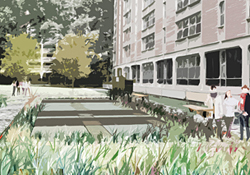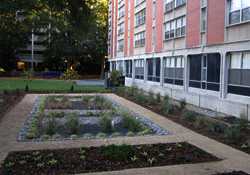Let It Rain – the New Lee Hall Rain Garden
Six months ago the area behind Lee Residence Hall on West Campus was a muddy patch. University Housing had no plans for the space. After consulting with Andy Fox and his landscape architecture students, however, University Housing agreed the students could transform the area into a sustainable rain garden.
It was a great idea. The rain garden would function as an attractive and inviting social space for student study and recreation while protecting the ecology in the area and creating a micro-habitat where butterflies and other pollinators can survive.

The newly unveiled Lee Hall Rain Garden achieves all of this and is part of an ongoing effort by the College of Design’s Department of Landscape Architecture and University Housing. The projects transform student accommodation by incorporating real sustainable construction projects into the curriculum. Students of landscape architecture get credit for participating.
“The whole campus is ripe with opportunities like this,” says Fox, an assistant professor of landscape architecture.
Busy at Work
Heather Rhymes, Danielle Toronyi, Johnson Bullard and Bob Shafer were the four graduate students tasked with beautifying and restoring the area behind Lee Hall. This meant working with University Housing and the design and construction services department over the summer to survey the area and design and construct a stormwater management system.
“We worked quickly and wore multiple hats,” Toronyi says.
For a project this large, the students struggled staying inside their modest budget and learned how to manage a team of 25 construction workers. And at the end of the day the project had to be beautiful, but also functional.
“Rain gardens slow water down the same way that nature does. These systems are engineered to mimic the natural systems you see in the woods,” Fox says.
The rain garden now prevents ponding, which attracts mosquitoes and other problems, and protects the newly restored Rocky Branch, an urban creek running through campus. The new rain garden contains a wide well with gravel and a perforated pipe. This filters contaminants which could otherwise flow into Rocky Branch.
“Without the rain garden, ongoing stagnant rainwater could deplete the stream’s ecology,” Fox says.

An Uplifting Experience
On a cool October morning Rhymes points out her favorite bits. She loves that the patchwork design of the garden duplicates the patchwork of the building. She adores the daylilies – these are thriving and have already bloomed twice- and the tranquility.
“Phase two of the design will include seating. This will be a study oasis,” she says.
Rhymes will seek a career in retrofitting upon graduating in May. Rain gardens have been around for 20-plus years, Fox says, but more big-city landscape architects are using low-impact development areas to deal with municipal stormwater. Creating these projects on NC State’s campus benefits everybody, he says.
“We take under-used land and make it something beautiful. Our students can learn on the job, be creative and give back.”
- Categories:


